Stewart J. Calculus
Подождите немного. Документ загружается.


about the -axis. Therefore, from Formula 7, we get
M
! 2
%
r
2
""cos t#
]
0
%
! 4
%
r
2
! 2
%
r
2
y
%
0
sin t dt
! 2
%
y
%
0
r sin t ! r dt! 2
%
y
%
0
r sin t
s
r
2
"sin
2
t # cos
2
t# dt
S !
y
%
0
2
%
r sin t
s
""r sin t#
2
# "r cos t#
2
dt
x
672
|| ||
CHAPTER 11 PARAMETRIC EQUATIONS AND POLAR COORDINATES
19. ,
20. ,
;
21. Use a graph to estimate the coordinates of the rightmost point
on the curve , . Then use calculus to find the
exact coordinates.
;
22. Use a graph to estimate the coordinates of the lowest point
and the leftmost point on the curve , .
Then find the exact coordinates.
;
23–24 Graph the curve in a viewing rectangle that displays all
the important aspects of the curve.
,
24. ,
Show that the curve , has two
tangents at and find their equations. Sketch the curve.
;
26. Graph the curve , to
discover where it crosses itself. Then find equations of both
tangents at that point.
27. (a) Find the slope of the tangent line to the trochoid
, in terms of . (See
Exercise 40 in Section 11.1.)
(b) Show that if , then the trochoid does not have a
vertical tangent.
28. (a) Find the slope of the tangent to the astroid ,
in terms of . (Astroids are explored in the
Laboratory Project on page 665.)
(b) At what points is the tangent horizontal or vertical?
(c) At what points does the tangent have slope 1 or ?
29. At what points on the curve , does
the tangent line have slope ?
30. Find equations of the tangents to the curve ,
that pass through the point .
Use the parametric equations of an ellipse, ,
, , to find the area that it encloses.0 +
!
+ 2
%
y ! b sin
!
x ! a cos
!
31.
"4, 3#y ! 2t
3
# 1
x ! 3t
2
# 1
1
y ! 1 # 4t " t
2
x ! 2t
3
"1
!
y ! a sin
3
!
x ! a cos
3
!
d
&
r
!
y ! r " d cos
!
x ! r
!
" d sin
!
y ! sin t # 2 sin 2tx ! cos t # 2 cos 2t
"0, 0#
y ! sin t cos tx ! cos t
25.
y ! 2t
2
" tx ! t
4
# 4t
3
" 8t
2
y ! t
3
" tx ! t
4
" 2t
3
" 2t
2
23.
y ! t # t
4
x ! t
4
" 2t
y ! e
t
x ! t " t
6
y ! 2 sin
!
x ! cos 3
!
y ! sin 2
!
x ! 2 cos
!
1–2 Find .
1. , 2. ,
3–6 Find an equation of the tangent to the curve at the point cor-
responding to the given value of the parameter.
3. , ;
4. , ;
, ;
6. , ;
7– 8 Find an equation of the tangent to the curve at the given
point by two methods: (a) without eliminating the parameter and
(b) by first eliminating the parameter.
7. , ;
8. , ;
;
9–10 Find an equation of the tangent(s) to the curve at the given
point. Then graph the curve and the tangent(s).
9. , ;
10. , ;
11–16 Find and . For which values of is the
curve concave upward?
, 12. ,
13. , 14. ,
15. , ,
16. , ,
17–20 Find the points on the curve where the tangent is horizon-
tal or vertical. If you have a graphing device, graph the curve to
check your work.
17. ,
18. , y ! 2t
3
# 3t
2
# 1x ! 2t
3
# 3t
2
" 12t
y ! t
3
" 12tx ! 10 " t
2
0
&
t
&
%
y ! cos tx ! cos 2t
0
&
t
&
2
%
y ! 3 cos tx ! 2 sin t
y ! t " ln tx ! t # ln ty ! t # e
"t
x ! t " e
t
y ! t
2
" 1x ! t
3
" 12ty ! t
2
# t
3
x ! 4 # t
2
11.
td
2
y!dx
2
dy!dx
""1, 1#y ! sin t # sin 2tx ! cos t # cos 2t
"0, 0#y ! t
2
# tx ! 6 sin t
(
1,
s
2
)
y ! sec
!
x ! tan
!
"1, 3#y ! t
2
# 2x ! 1 # ln t
!
! 0y ! sin
!
# cos 2
!
x ! cos
!
# sin 2
!
t ! 1y ! t " ln t
2
x ! e
s
t
5.
t ! 1y ! 1 # t
2
x ! t " t
"1
t ! "1y ! t
3
# tx ! t
4
# 1
y !
s
t
e
"t
x ! 1!ty ! t
2
# tx ! t sin t
dy!dx
E X E R C I S E S
11.2
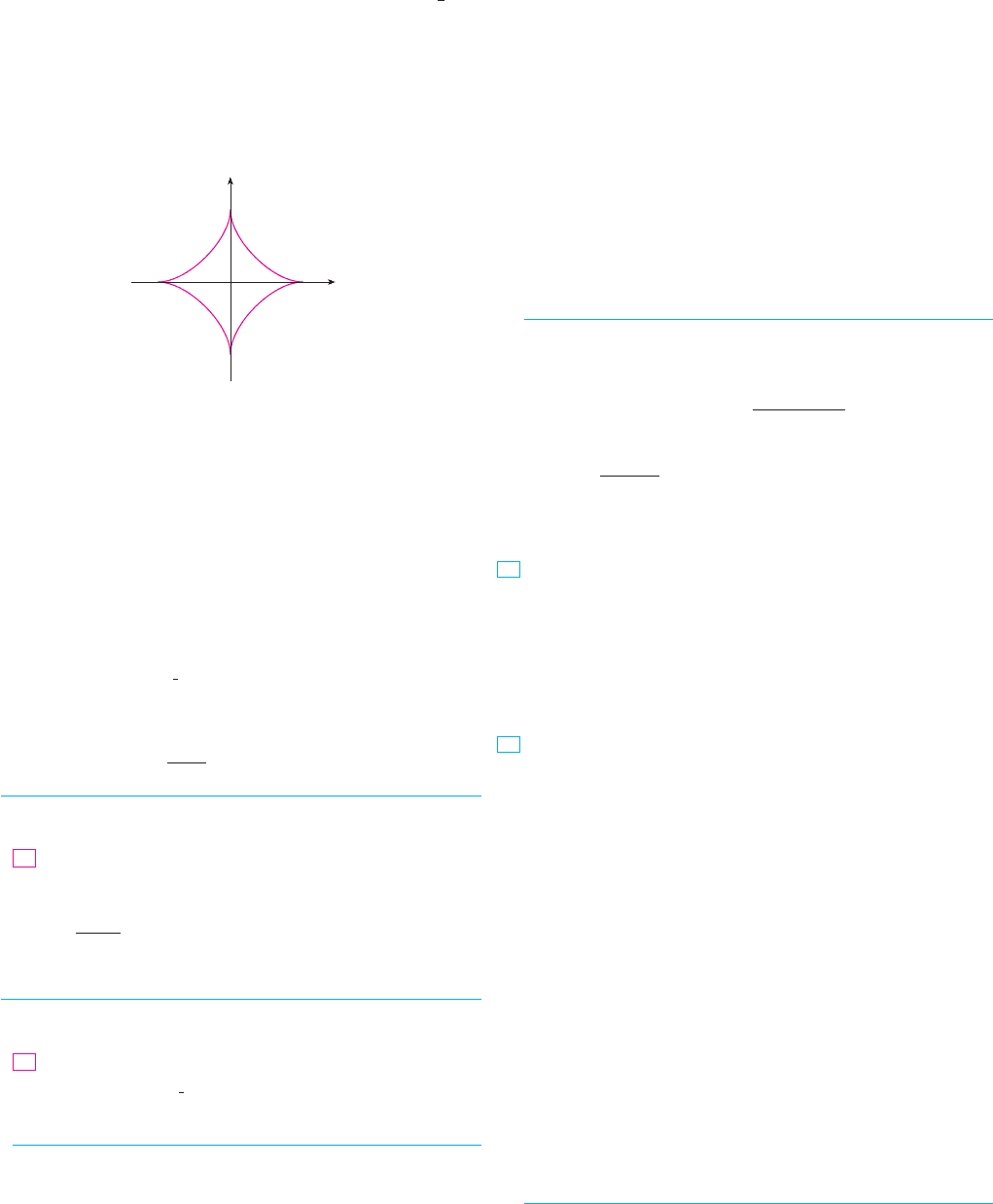
49. Use Simpson’s Rule with to estimate the length of the
curve , , .
50. In Exercise 43 in Section 11.1 you were asked to derive the
parametric equations , for the
curve called the witch of Maria Agnesi. Use Simpson’s Rule
with to estimate the length of the arc of this curve
given by .
51–52 Find the distance traveled by a particle with position
as varies in the given time interval. Compare with the length of
the curve.
51. , ,
52. , ,
53. Show that the total length of the ellipse ,
, , is
where is the eccentricity of the ellipse , where
.
54. Find the total length of the astroid , ,
where
55. (a) Graph the epitrochoid with equations
What parameter interval gives the complete curve?
(b) Use your CAS to find the approximate length of this
curve.
56. A curve called Cornu’s spiral is defined by the parametric
equations
where and are the Fresnel functions that were introduced
in Chapter 5.
(a) Graph this curve. What happens as and as
?
(b) Find the length of Cornu’s spiral from the origin to the
point with parameter value .
57–58 Set up an integral that represents the area of the surface
obtained by rotating the given curve about the -axis. Then use
your calculator to find the surface area correct to four decimal
places.
57. , ,
58. , , 0 + t +
%
!3y ! sin 3tx ! sin
2
t
0 + t + 1y ! "t
2
# 1#e
t
x ! 1 # te
t
x
t
t l "-
t l -
SC
y ! S"t# !
y
t
0
sin"
%
u
2
!2# du
x ! C"t# !
y
t
0
cos"
%
u
2
!2# du
CAS
y ! 11 sin t " 4 sin"11t!2#
x ! 11 cos t " 4 cos"11t!2#
CAS
a ' 0.
y ! a sin
3
!
x ! a cos
3
!
c !
s
a
2
" b
2
)
(
e ! c!ae
L ! 4a
y
%
!2
0
s
1 " e
2
sin
2
!
d
!
a ' b ' 0y ! b cos
!
x ! a sin
!
0 + t + 4
%
y ! cos tx ! cos
2
t
0 + t + 3
%
y ! cos
2
tx ! sin
2
t
t
"x, y#
%
!4 +
!
+
%
!2
n ! 4
y ! 2a sin
2
!
x ! 2a cot
!
"6 + t + 6y ! t # e
t
x ! t " e
t
n ! 6
32. Find the area enclosed by the curve , and
the .
33. Find the area enclosed by the and the curve
, .
34. Find the area of the region enclosed by the astroid
, . (Astroids are explored in the Labo-
ratory Project on page 665.)
35. Find the area under one arch of the trochoid of Exercise 40 in
Section 11.1 for the case .
36. Let be the region enclosed by the loop of the curve in
Example 1.
(a) Find the area of .
(b) If is rotated about the -axis, find the volume of the
resulting solid.
(c) Find the centroid of .
37– 40 Set up an integral that represents the length of the curve.
Then use your calculator to find the length correct to four decimal
places.
37. , ,
38. , ,
39. , ,
40. , ,
41– 44 Find the exact length of the curve.
, ,
42. , ,
43. , ,
44. , ,
;
45– 47 Graph the curve and find its length.
, ,
46. , ,
47. , ,
48. Find the length of the loop of the curve ,
.y ! 3t
2
x ! 3t " t
3
"8 + t + 3y ! 4e
t!2
x ! e
t
" t
%
!4 + t + 3
%
!4y ! sin tx ! cos t # ln
(
tan
1
2
t
)
0 + t +
%
y ! e
t
sin tx ! e
t
cos t
45.
0 + t +
%
y ! 3 sin t " sin 3tx ! 3 cos t " cos 3t
0 + t + 2y ! ln"1 # t#x !
t
1 # t
0 + t + 3y ! 5 " 2tx ! e
t
# e
"t
0 + t + 1y ! 4 # 2t
3
x ! 1 # 3t
2
41.
1 + t + 5y !
s
t # 1x ! ln t
0 + t + 2
%
y ! t " sin tx ! t # cos t
"3 + t + 3y ! t
2
x ! 1 # e
t
1 + t + 2y !
4
3
t
3!2
x ! t " t
2
!
x!
!
!
d
&
r
y
x
0
a_a
_a
a
y ! a sin
3
!
x ! a cos
3
!
y ! t " t
2
x ! 1 # e
t
x-axis
y-axis
y !
s
t
x ! t
2
" 2t
SECTION 11.2 CALCULUS WITH PARAMETRIC CURVES
|| ||
673
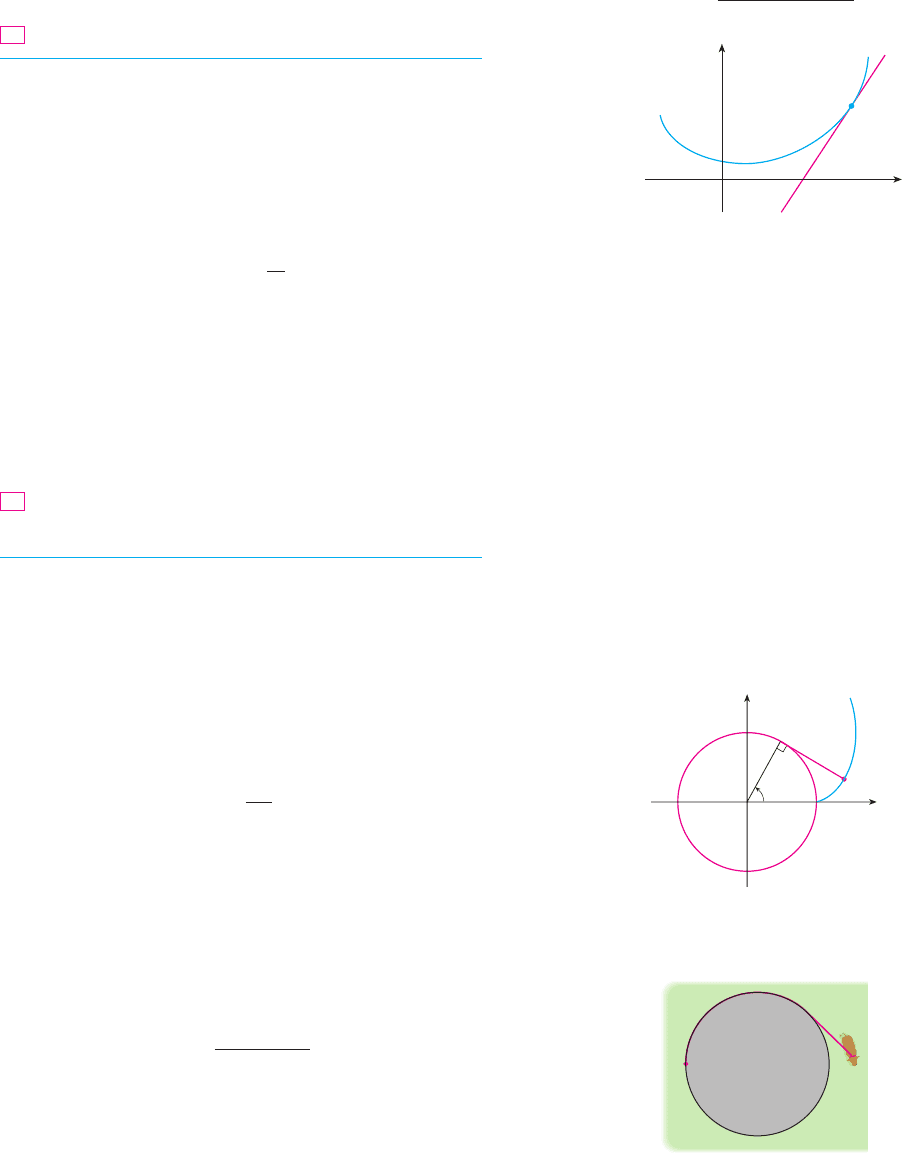
(b) By regarding a curve as the parametric curve
, , with parameter , show that the formula
in part (a) becomes
70. (a) Use the formula in Exercise 69(b) to find the curvature of
the parabola at the point .
(b) At what point does this parabola have maximum
curvature?
71. Use the formula in Exercise 69(a) to find the curvature of the
cycloid , at the top of one of its
arches.
72. (a) Show that the curvature at each point of a straight line
is .
(b) Show that the curvature at each point of a circle of
radius is .
73. A string is wound around a circle and then unwound while
being held taut. The curve traced by the point at the end of
the string is called the involute of the circle. If the circle has
radius and center and the initial position of is ,
and if the parameter is chosen as in the figure, show
that parametric equations of the involute are
74. A cow is tied to a silo with radius by a rope just long
enough to reach the opposite side of the silo. Find the area
available for grazing by the cow.
r
x
O
y
r
¨
P
T
y ! r "sin
!
"
!
cos
!
#x ! r"cos
!
#
!
sin
!
#
!
"r, 0#POr
P
/
! 1!rr
/
! 0
y ! 1 " cos
!
x !
!
" sin
!
"1, 1#y ! x
2
0
x
y
P
˙
/
!
+
d
2
y!dx
2
+
(1 # "dy!dx#
2
)
3!2
xy ! f "x#x ! x
y ! f "x#
59–61 Find the exact area of the surface obtained by rotating the
given curve about the -axis.
59. , ,
60. , ,
, ,
;
62. Graph the curve
If this curve is rotated about the -axis, find the area of the
resulting surface. (Use your graph to help find the correct
parameter interval.)
63. If the curve
is rotated about the -axis, use your calculator to estimate the
area of the resulting surface to three decimal places.
64. If the arc of the curve in Exercise 50 is rotated about the
-axis, estimate the area of the resulting surface using Simp-
son’s Rule with .
65–66 Find the surface area generated by rotating the given
curve about the -axis.
, ,
66. , ,
67. If is continuous and for , show that the
parametric curve , , , can be put in
the form . [Hint: Show that exists.]
68. Use Formula 2 to derive Formula 7 from Formula 9.2.5 for
the case in which the curve can be represented in the form
, .
69. The curvature at a point of a curve is defined as
where is the angle of inclination of the tangent line at ,
as shown in the figure. Thus the curvature is the absolute
value of the rate of change of with respect to arc length. It
can be regarded as a measure of the rate of change of direc-
tion of the curve at and will be studied in greater detail in
Chapter 14.
(a) For a parametric curve , , derive the
formula
where the dots indicate derivatives with respect to , so
. [Hint: Use and Formula 2
to find . Then use the Chain Rule to find .]d
0
!dsd
0
!dt
0
! tan
"1
"dy!dx#x# ! dx!dt
t
/
!
+
x#y## " x##y#
+
(x#
2
# y#
2
)
3!2
y ! y"t#x ! x"t#
P
0
P
0
/
!
-
d
0
ds
-
P
a + x + by ! F"x#
f
"1
y ! F"x#
a + t + by ! t"t#x ! f "t#
a + t + bf $"t# " 0f $
0 + t + 1y ! 4e
t!2
x ! e
t
" t
0 + t + 5y ! 2t
3
x ! 3t
2
65.
y
n ! 4
x
x
1 + t + 2y ! t "
1
t
2
x ! t # t
3
x
y ! 2 sin
!
" sin 2
!
x ! 2 cos
!
" cos 2
!
0 +
!
+
%
!2y ! a sin
3
!
x ! a cos
3
!
61.
0 + t + 1y ! 3t
2
x ! 3t " t
3
0 + t + 1y ! t
2
x ! t
3
x
674
|| ||
CHAPTER 11 PARAMETRIC EQUATIONS AND POLAR COORDINATES
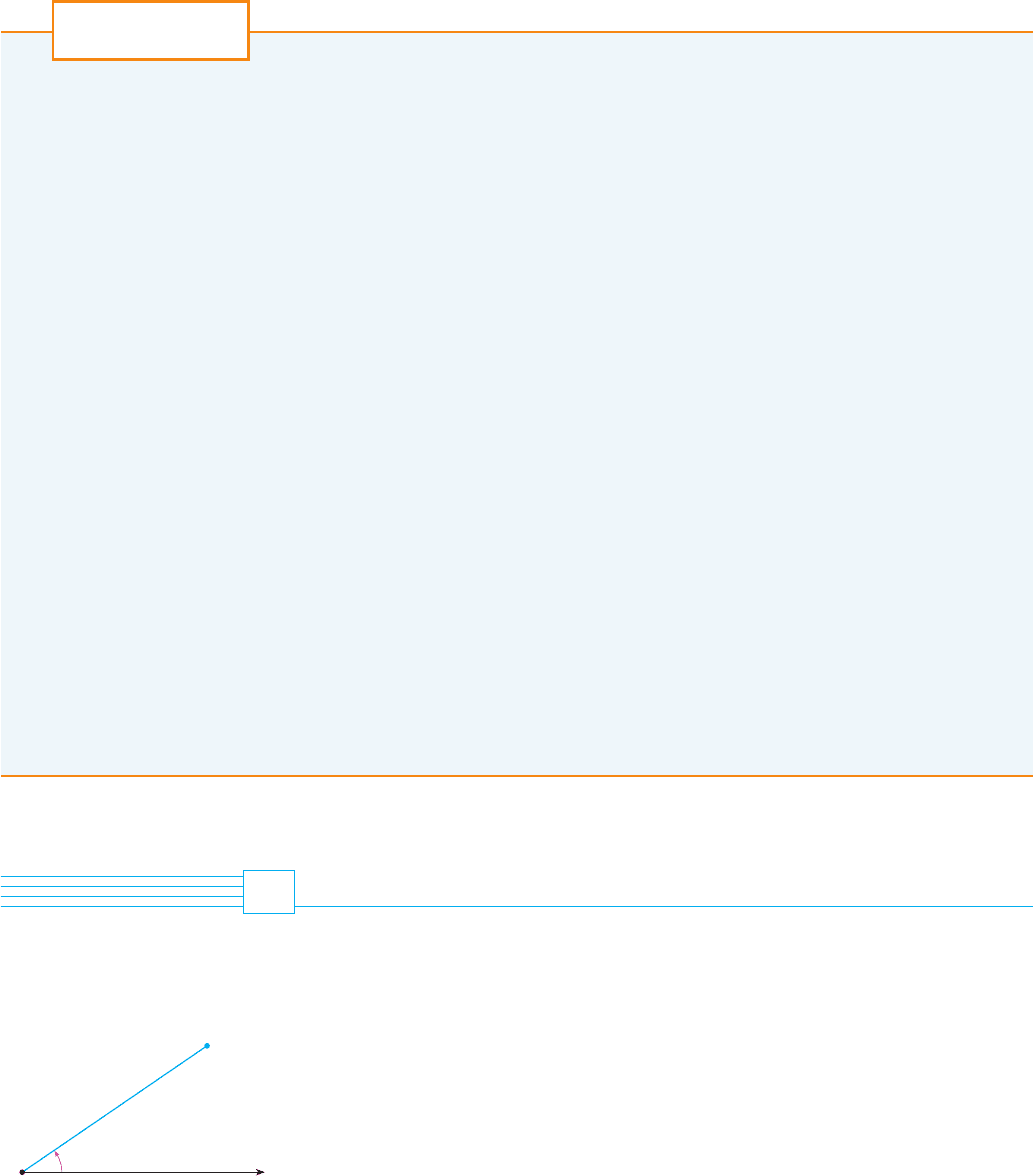
The Bézier curves are used in computer-aided design and are named after the French mathema-
tician Pierre Bézier (1910–1999), who worked in the automotive industry. A cubic Bézier curve
is determined by four control points, and , and is
defined by the parametric equations
where . Notice that when we have and when we have
, so the curve starts at and ends at .
1. Graph the Bézier curve with control points , , , and
Then, on the same screen, graph the line segments , , and . (Exercise 31 in
Section 11.1 shows how to do this.) Notice that the middle control points and don’t lie
on the curve; the curve starts at , heads toward and without reaching them, and ends
at
2. From the graph in Problem 1, it appears that the tangent at passes through and the
tangent at passes through . Prove it.
3. Try to produce a Bézier curve with a loop by changing the second control point in
Problem 1.
4. Some laser printers use Bézier curves to represent letters and other symbols. Experiment
with control points until you find a Bézier curve that gives a reasonable representation of the
letter C.
5. More complicated shapes can be represented by piecing together two or more Bézier curves.
Suppose the first Bézier curve has control points and the second one has con-
trol points . If we want these two pieces to join together smoothly, then the
tangents at should match and so the points , , and all have to lie on this common
tangent line. Using this principle, find control points for a pair of Bézier curves that repre-
sent the letter S.
P
4
P
3
P
2
P
3
P
3
, P
4
, P
5
, P
6
P
0
, P
1
, P
2
, P
3
P
2
P
3
P
1
P
0
P
3
.
P
2
P
1
P
0
P
2
P
1
P
2
P
3
P
1
P
2
P
0
P
1
P
3
"40, 5#.P
2
"50, 42#P
1
"28, 48#P
0
"4, 1#
P
3
P
0
"x, y# ! "x
3
, y
3
#
t ! 1
"x, y# ! "x
0
, y
0
#
t ! 00 + t + 1
y ! y
0
"1 " t#
3
# 3y
1
t"1 " t#
2
# 3y
2
t
2
"1 " t# # y
3
t
3
x ! x
0
"1 " t#
3
# 3x
1
t"1 " t#
2
# 3x
2
t
2
"1 " t# # x
3
t
3
P
3
"x
3
, y
3
#P
0
"x
0
, y
0
#, P
1
"x
1
, y
1
#, P
2
"x
2
, y
2
#,
SECTION 11.3 POLAR COORDINATES
|| ||
675
POLAR COORDINATES
A coordinate system represents a point in the plane by an ordered pair of numbers called
coordinates. Usually we use Cartesian coordinates, which are directed distances from two
perpendicular axes. Here we describe a coordinate system introduced by Newton, called
the polar coordinate system, which is more convenient for many purposes.
We choose a point in the plane that is called the pole (or origin) and is labeled . Then
we draw a ray (half-line) starting at called the polar axis. This axis is usually drawn hor-
izontally to the right and corresponds to the positive -axis in Cartesian coordinates.
If is any other point in the plane, let be the distance from to and let be the
angle (usually measured in radians) between the polar axis and the line as in Figure 1.
Then the point is represented by the ordered pair and , are called polar coordi-
nates of . We use the convention that an angle is positive if measured in the counter-
clockwise direction from the polar axis and negative in the clockwise direction. If ,
then and we agree that represents the pole for any value of .
!
"0,
!
#r ! 0
P ! O
P
!
r"r,
!
#P
OP
!
POrP
x
O
O
11.3
x
O
¨
r
polar axis
P(r,¨ )
F I G U R E 1
;
BE
´
ZIER CURVES
L A B O R A T O R Y
P R O J E C T
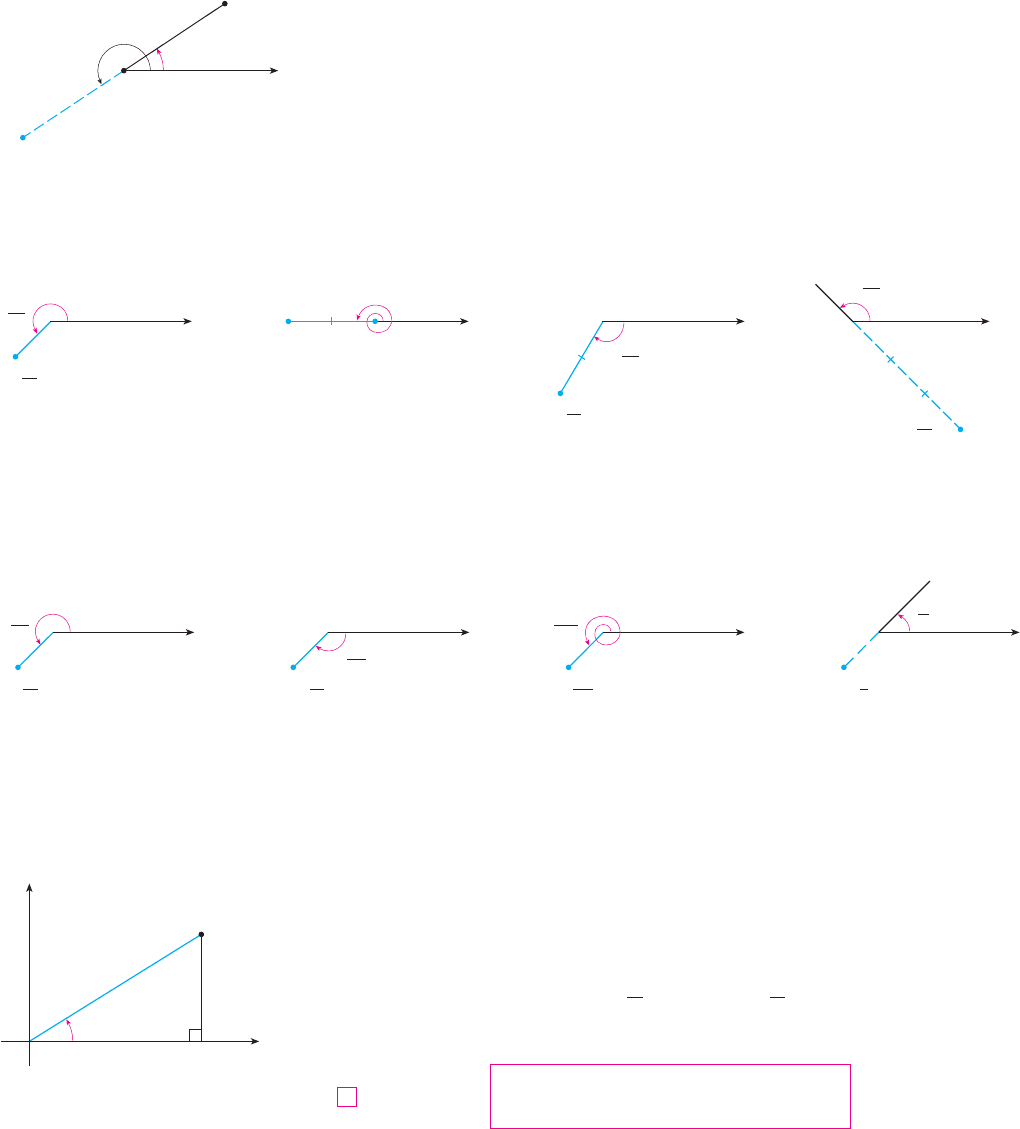
We extend the meaning of polar coordinates to the case in which is negative by
agreeing that, as in Figure 2, the points and lie on the same line through
and at the same distance from , but on opposite sides of . If , the point
lies in the same quadrant as ; if , it lies in the quadrant on the opposite side of the
pole. Notice that represents the same point as .
EXAMPLE 1 Plot the points whose polar coordinates are given.
(a) (b) (c) (d)
SOLUTION The points are plotted in Figure 3. In part (d) the point is located
three units from the pole in the fourth quadrant because the angle is in the second
quadrant and is negative.
M
In the Cartesian coordinate system every point has only one representation, but in the
polar coordinate system each point has many representations. For instance, the point
in Example 1(a) could be written as or or .
(See Figure 4.)
In fact, since a complete counterclockwise rotation is given by an angle 2 , the point
represented by polar coordinates is also represented by
where is any integer.
The connection between polar and Cartesian coordinates can be seen from Figure 5, in
which the pole corresponds to the origin and the polar axis coincides with the positive
-axis. If the point has Cartesian coordinates and polar coordinates , then,
from the figure, we have
and so
Although Equations 1 were deduced from Figure 5, which illustrates the case where
and , these equations are valid for all values of and (See the gen-
eral definition of and in Appendix D.)cos
!
sin
!
!
.r0
"
!
"
#
!2r $ 0
y ! r sin
!
x ! r cos
!
1
sin
!
!
y
r
cos
!
!
x
r
"r,
!
#"x, y#Px
n
"%r,
!
& "2n & 1#
#
#and"r,
!
& 2n
#
#
"r,
!
#
#
O
13π
4
”1,
’
13π
4
O
_
3π
4
”1,_
’
3π
4
O
”1, ’
5π
4
5π
4
F I G U R E 4
O
”_1,’
π
4
π
4
"%1,
#
!4#"1, 13
#
!4#"1, %3
#
!4#"1, 5
#
!4#
O
”_3, ’
3π
4
3π
4
(2,3π)
O
3π
”1, ’
5π
4
5π
4
O
F I G U R E 3
O
”2,_
’
2π
3
2π
3
_
r ! %3
3
#
!4
"%3, 3
#
!4#
"%3, 3
#
!4#"2, %2
#
!3#"2, 3
#
#"1, 5
#
!4#
"r,
!
&
#
#"%r,
!
#
r
"
0
!
"r,
!
#r $ 0OO
$
r
$
O"r,
!
#"%r,
!
#
r"r,
!
#
676
|| ||
CHAPTER 11 PARAMETRIC EQUATIONS AND POLAR COORDINATES
(_r,¨)
O
¨
(r,¨)
¨+π
F I G U R E 2
O
y
x
¨
x
y
r
P(r,¨)=P(x,y)
F I G U R E 5

Equations 1 allow us to find the Cartesian coordinates of a point when the polar coor-
dinates are known. To find and when and are known, we use the equations
which can be deduced from Equations 1 or simply read from Figure 5.
EXAMPLE 2 Convert the point from polar to Cartesian coordinates.
SOLUTION Since and , Equations 1 give
Therefore the point is in Cartesian coordinates.
M
EXAMPLE 3 Represent the point with Cartesian coordinates in terms of polar
coordinates.
SOLUTION If we choose to be positive, then Equations 2 give
Since the point lies in the fourth quadrant, we can choose or
. Thus one possible answer is ; another is .
M
Equations 2 do not uniquely determine when and are given because, as
increases through the interval , each value of occurs twice. Therefore, in
converting from Cartesian to polar coordinates, it’s not good enough just to find and
that satisfy Equations 2. As in Example 3, we must choose so that the point lies in
the correct quadrant.
POLAR CURVES
The graph of a polar equation , or more generally , consists of all
points that have at least one polar representation whose coordinates satisfy the
equation.
EXAMPLE 4 What curve is represented by the polar equation ?
SOLUTION The curve consists of all points with . Since represents the distance
from the point to the pole, the curve represents the circle with center and radius
. In general, the equation represents a circle with center and radius . (See
Figure 6.) M
$
a
$
Or ! a2
Or ! 2
rr ! 2"r,
!
#
r ! 2
V
"r,
!
#P
F"r,
!
# ! 0r ! f "
!
#
"r,
!
#
!
!
r
tan
!
0 '
!
"
2
#
!
yx
!
NOTE
"
s
2
, 7
#
!4#
(
s
2
, %
#
!4
)
!
! 7
#
!4
!
! %
#
!4"1, %1#
tan
!
!
y
x
! %1
r !
s
x
2
& y
2
!
s
1
2
& "%1#
2
!
s
2
r
"1, %1#
(
1,
s
3
)
y ! r sin
!
! 2 sin
#
3
! 2 !
s
3
2
!
s
3
x ! r cos
!
! 2 cos
#
3
! 2 !
1
2
! 1
!
!
#
!3r ! 2
"2,
#
!3#
tan
!
!
y
x
r
2
! x
2
& y
2
2
yx
!
r
SECTION 11.3 POLAR COORDINATES
|| ||
677
F I G U R E 6
x
r=
1
2
r=1
r=2
r=4
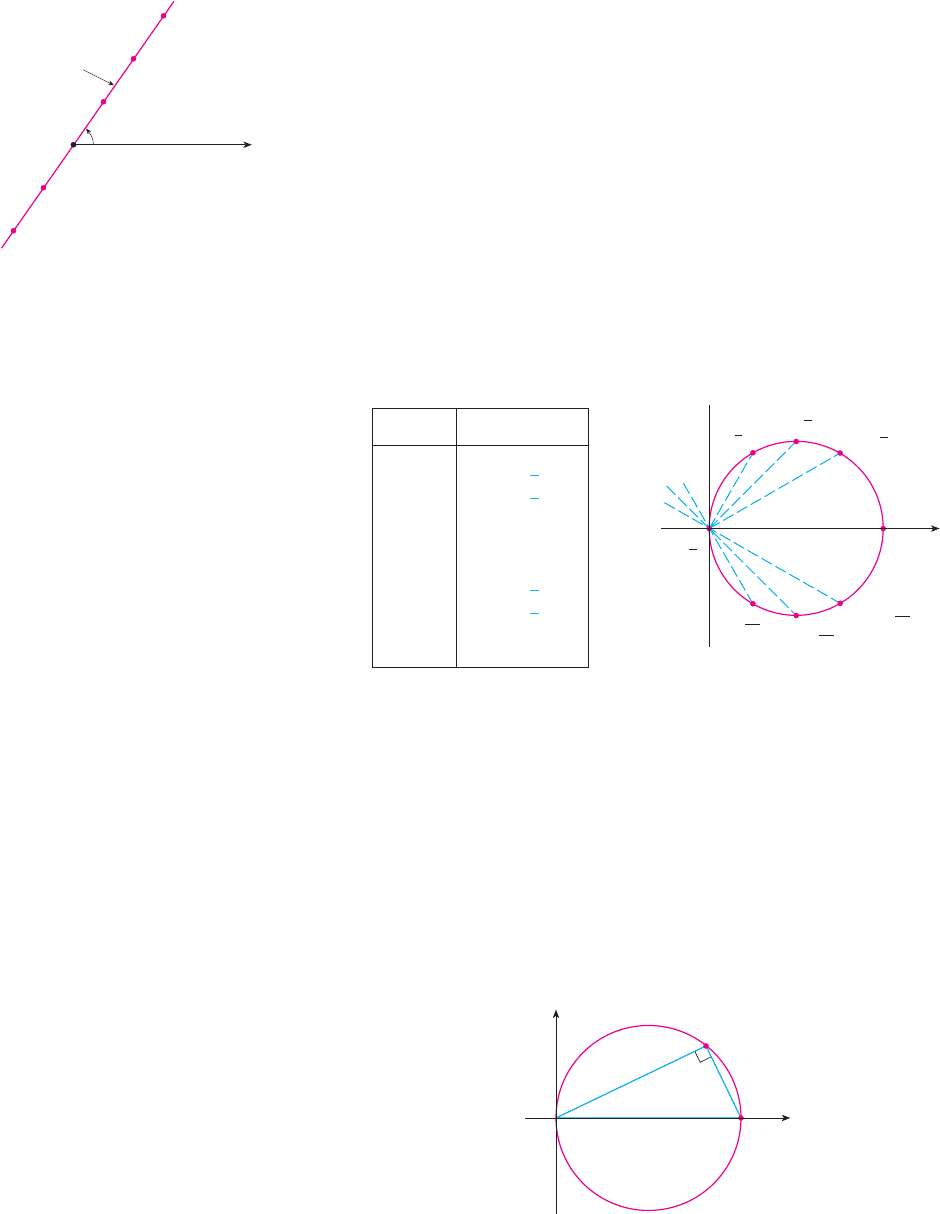
EXAMPLE 5 Sketch the polar curve .
SOLUTION This curve consists of all points such that the polar angle is 1 radian. It
is the straight line that passes through and makes an angle of 1 radian with the polar
axis (see Figure 7). Notice that the points on the line with are in the first
quadrant, whereas those with are in the third quadrant. M
EXAMPLE 6
(a) Sketch the curve with polar equation .
(b) Find a Cartesian equation for this curve.
SOLUTION
(a) In Figure 8 we find the values of for some convenient values of and plot the
corresponding points . Then we join these points to sketch the curve, which appears
to be a circle. We have used only values of between 0 and , since if we let increase
beyond , we obtain the same points again.
(b) To convert the given equation to a Cartesian equation we use Equations 1 and 2.
From we have , so the equation becomes ,
which gives
or
Completing the square, we obtain
which is an equation of a circle with center and radius 1. M
F I G U R E 9
O
y
x
2
¨
r
P
Q
"1, 0#
"x % 1#
2
& y
2
! 1
x
2
& y
2
% 2x ! 02x ! r
2
! x
2
& y
2
r ! 2x!rr ! 2 cos
!
cos
!
! x!rx ! r cos
!
F I G U R E 8
Table of values and
graph of r=2cos¨
(2,0)
2
”_1,’
2π
3
”0,’
π
2
”1,’
π
3
”œ
„
,’
π
4
”œ
„
,’
π
6
3
”_ œ
„
, ’
5π
6
3
”_ œ
„
, ’
3π
4
2
#
!
#
!
"r,
!
#
!
r
r ! 2 cos
!
r
"
0
r $ 0"r, 1#
O
!
"r,
!
#
!
! 1
678
|| ||
CHAPTER 11 PARAMETRIC EQUATIONS AND POLAR COORDINATES
O
x
1
(_1,1)
(_2,1)
(1,1)
(2,1)
(3,1)
¨=1
F I G U R E 7
0 2
1
0
%1
%2
#
%
s
35
#
!6
%
s
2
3
#
!4
2
#
!3
#
!2
#
!3
s
2
#
!4
s
3
#
!6
r ! 2 cos
!
!
N Figure 9 shows a geometrical illustration
that the circle in Example 6 has the equation
. The angle is a right angle
(Why?) and so .r!2 ! cos
!
OPQr ! 2 cos
!

EXAMPLE 7 Sketch the curve .
SOLUTION Instead of plotting points as in Example 6, we first sketch the graph of
in Cartesian coordinates in Figure 10 by shifting the sine curve up one
unit. This enables us to read at a glance the values of that correspond to increasing
values of . For instance, we see that as increases from 0 to , (the distance from )
increases from 1 to 2, so we sketch the corresponding part of the polar curve in Figure
11(a). As increases from to , Figure 10 shows that decreases from 2 to 1, so we
sketch the next part of the curve as in Figure 11(b). As increases from to ,
decreases from 1 to 0 as shown in part (c). Finally, as increases from to ,
increases from 0 to 1 as shown in part (d). If we let increase beyond or decrease
beyond 0, we would simply retrace our path. Putting together the parts of the curve from
Figure 11(a)–(d), we sketch the complete curve in part (e). It is called a cardioid,
because it’s shaped like a heart.
M
EXAMPLE 8 Sketch the curve .
SOLUTION As in Example 7, we first sketch , , in Cartesian coordi-
nates in Figure 12. As increases from 0 to , Figure 12 shows that decreases from
1 to 0 and so we draw the corresponding portion of the polar curve in Figure 13 (indi-
cated by
!
). As increases from to , goes from 0 to . This means that the
distance from increases from 0 to 1, but instead of being in the first quadrant this por-
tion of the polar curve (indicated by
@
) lies on the opposite side of the pole in the third
quadrant. The remainder of the curve is drawn in a similar fashion, with the arrows and
numbers indicating the order in which the portions are traced out. The resulting curve
has four loops and is called a four-leaved rose.
M
¨=0
¨=π
⑧
¨=
3π
4
¨=
π
2
¨=
π
4
F I G U R E 1 2
r=cos2¨ in Cartesian coordinates
F I G U R E 1 3
Four-leaved rose r=cos2¨
r
1
¨
2ππ
5π
4
π
2
π
4
3π
4
3π
2
7π
4
!
@
#
^
&
%
*
$
!
@
#
$
%
& ^
O
%1r
#
!2
#
!4
!
r
#
!4
!
0 '
!
' 2
#
r ! cos 2
!
r ! cos 2
!
(a) (b) (c) (d) (e)
F I G U R E 1 1
Stages in sketching the cardioid r=1+sin¨
O
¨=π
¨=
π
2
O
¨=π
¨=
3π
2
O
¨=2π
¨=
3π
2
O
O
¨=0
¨=
π
2
1
2
2
#
!
r
2
#
3
#
!2
!
r
3
#
!2
#
!
r
#
#
!2
!
Or
#
!2
!
!
r
r ! 1 & sin
!
r ! 1 & sin
!
V
SECTION 11.3 POLAR COORDINATES
|| ||
679
F I G U R E 1 0
r=1+sin¨ in Cartesian coordinates,
0¯¨¯2π
0
r
1
2
¨
π
2π
3π
2
π
2
Module 11.3 helps you see how
polar curves are traced out by showing
animations similar to Figures 10–13.
TE C
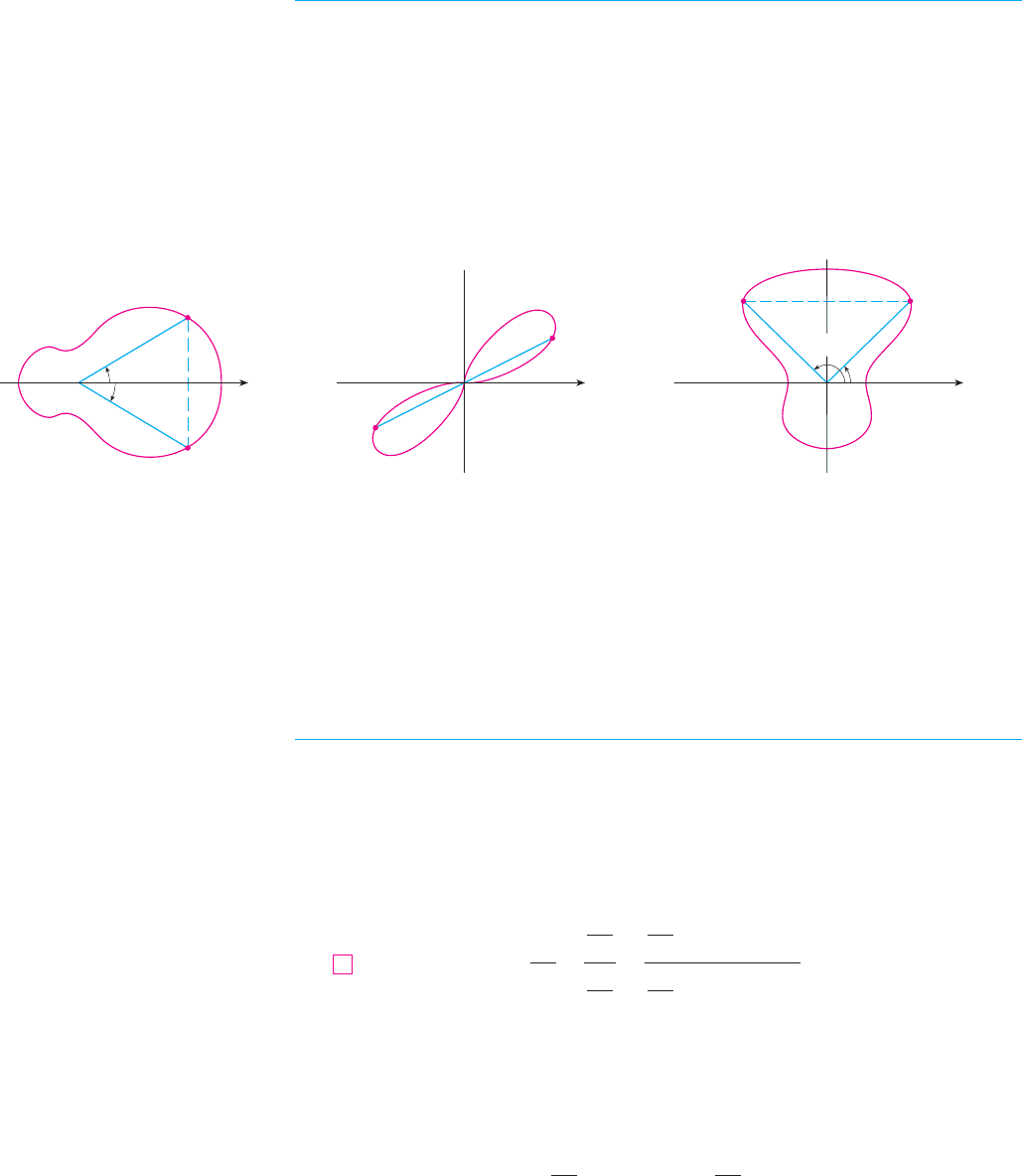
SYMMETRY
When we sketch polar curves, it is sometimes helpful to take advantage of symmetry. The
following three rules are explained by Figure 14.
(a) If a polar equation is unchanged when is replaced by , the curve is symmetric
about the polar axis.
(b) If the equation is unchanged when is replaced by , or when is replaced by
, the curve is symmetric about the pole. (This means that the curve remains
unchanged if we rotate it through 180° about the origin.)
(c) If the equation is unchanged when is replaced by , the curve is symmetric
about the vertical line .
The curves sketched in Examples 6 and 8 are symmetric about the polar axis, since
. The curves in Examples 7 and 8 are symmetric about because
and . The four-leaved rose is also symmetric
about the pole. These symmetry properties could have been used in sketching the curves.
For instance, in Example 6 we need only have plotted points for and then
reflected about the polar axis to obtain the complete circle.
TANGENTS TO POLAR CURVES
To find a tangent line to a polar curve , we regard as a parameter and write its
parametric equations as
Then, using the method for finding slopes of parametric curves (Equation 11.2.2) and the
Product Rule, we have
We locate horizontal tangents by finding the points where (provided that
). Likewise, we locate vertical tangents at the points where (pro-
vided that ).
Notice that if we are looking for tangent lines at the pole, then and Equation 3 sim-
plifies to
dr
d
!
" 0if
dy
dx
! tan
!
r ! 0
dy!d
!
" 0
dx!d
!
! 0dx!d
!
" 0
dy!d
!
! 0
dy
dx
!
dy
d
!
dx
d
!
!
dr
d
!
sin
!
& r cos
!
dr
d
!
cos
!
% r sin
!
3
y ! r sin
!
! f "
!
# sin
!
x ! r cos
!
! f "
!
# cos
!
!
r ! f "
!
#
0 '
!
'
#
!2
cos 2"
#
%
!
# ! cos 2
!
sin"
#
%
!
# ! sin
!
!
!
#
!2cos"%
!
# ! cos
!
O
(r,¨)
(_r,¨)
O
(r,¨)
(r,_¨)
_¨
¨
(a) (b) (c)
F I G U R E 1 4
O
(r,¨)(r,π-¨)
π-¨
¨
!
!
#
!2
#
%
!
!
!
&
#
!
%rr
%
!
!
680
|| ||
CHAPTER 11 PARAMETRIC EQUATIONS AND POLAR COORDINATES
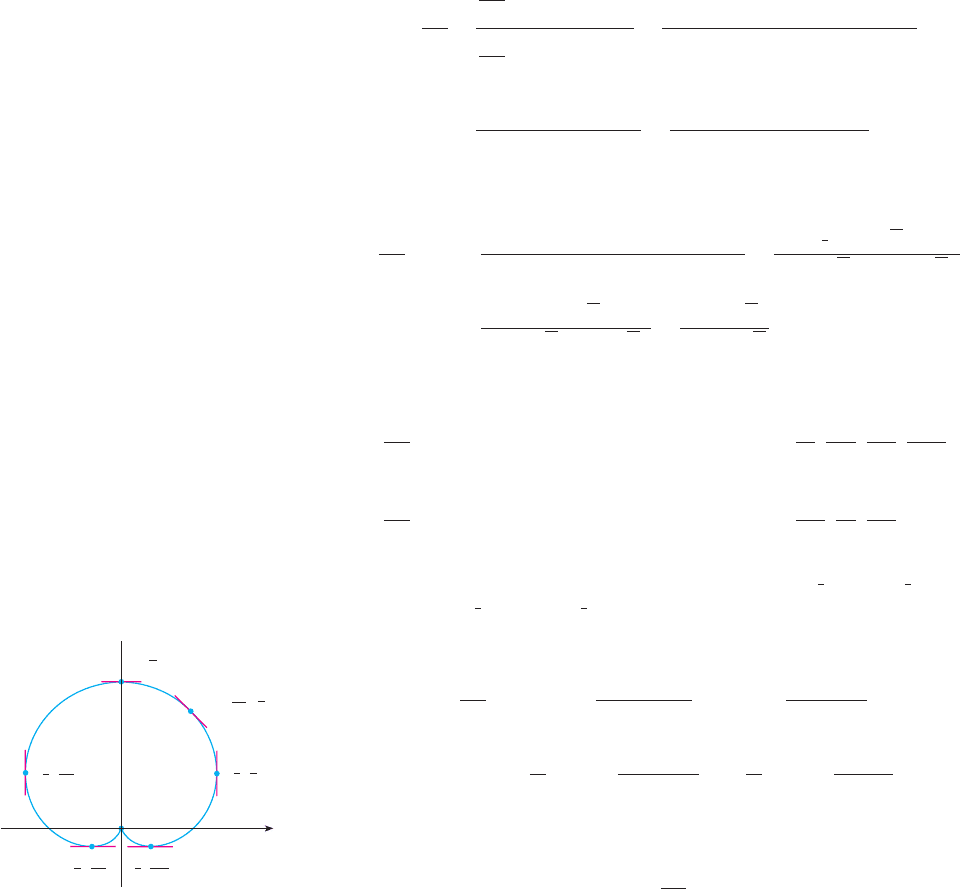
For instance, in Example 8 we found that when or . This
means that the lines and (or and ) are tangent lines to
at the origin.
EXAMPLE 9
(a) For the cardioid of Example 7, find the slope of the tangent line
when .
(b) Find the points on the cardioid where the tangent line is horizontal or vertical.
SOLUTION
Using Equation 3 with , we have
(a) The slope of the tangent at the point where is
(b) Observe that
Therefore there are horizontal tangents at the points , , and
vertical tangents at and . When , both and
are 0, so we must be careful. Using l’Hospital’s Rule, we have
By symmetry,
Thus there is a vertical tangent line at the pole (see Figure 15).
M
lim
!
l
"3
#
!2#
&
dy
dx
! %(
! %
1
3
lim
!
l
"3
#
!2#
%
%sin
!
cos
!
! (! %
1
3
lim
!
l
"3
#
!2#
%
cos
!
1 & sin
!
lim
!
l
"3
#
!2#
%
dy
dx
!
%
lim
!
l
"3
#
!2#
%
1 & 2 sin
!
1 % 2 sin
!
&%
lim
!
l
"3
#
!2#
%
cos
!
1 & sin
!
&
dx!d
!
dy!d
!
!
! 3
#
!2
(
3
2
, 5
#
!6
)(
3
2
,
#
!6
)
(
1
2
, 11
#
!6
)(
1
2
, 7
#
!6
)
"2,
#
!2#
when
!
!
3
#
2
,
#
6
,
5
#
6
dx
d
!
! "1 & sin
!
#"1 % 2 sin
!
# ! 0
when
!
!
#
2
,
3
#
2
,
7
#
6
,
11
#
6
dy
d
!
! cos
!
"1 & 2 sin
!
# ! 0
!
1 &
s
3
%1 %
s
3
! %1!
1 &
s
3
(
2 &
s
3
)(
1 %
s
3
)
!
1
2
(
1 &
s
3
)
(
1 &
s
3
!2
)(
1 %
s
3
)
dy
dx
'
!
!
#
!3
!
cos"
#
!3#"1 & 2 sin"
#
!3##
"1 & sin"
#
!3##"1 % 2 sin"
#
!3##
!
!
#
!3
!
cos
!
"1 & 2 sin
!
#
1 % 2 sin
2
!
% sin
!
!
cos
!
"1 & 2 sin
!
#
"1 & sin
!
#"1 % 2 sin
!
#
dy
dx
!
dr
d
!
sin
!
& r cos
!
dr
d
!
cos
!
% r sin
!
!
cos
!
sin
!
& "1 & sin
!
# cos
!
cos
!
cos
!
% "1 & sin
!
# sin
!
r ! 1 & sin
!
!
!
#
!3
r ! 1 & sin
!
r ! cos 2
!
y ! %xy ! x
!
! 3
#
!4
!
!
#
!4
3
#
!4
!
!
#
!4r ! cos 2
!
! 0
SECTION 11.3 POLAR COORDINATES
|| ||
681
5π
6
”, ’
3
2
7π
6
”, ’
1
2
”, ’
11π
6
1
2
3
2
π
6
” , ’
(0,0)
m=_1
”1+ ,’
π
3
œ
„3
2
”2,’
π
2
F I G U R E 1 5
Tangent lines for r=1+sin¨
Openmirrors.com
